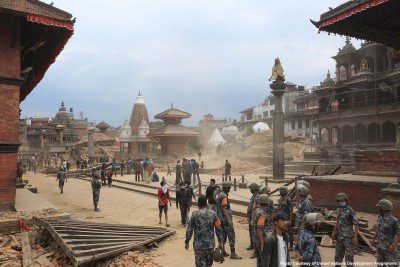Sarmiento is a professor in FIU’s Robert Stempel College of Public Health and Social Work and the director of the Disaster Risk Reduction Program in the FIU Extreme Events Institute. He was among a team of experts that visited Nepal in 2011 as part of the U.S. Mission to Nepal, which is committed to supporting the government of Nepal’s efforts in planning for a disaster.
 This weekend’s massive earthquake, the country’s worst in 80 years, shook the densely populated capital city of Kathmandu, killing thousands and injuring many more. The epicenter of the quake hit in Nepal’s seismically unstable Himalayas, resulting in avalanches on Mount Everest, the country’s most famous attraction. The actual extent of the damage nationwide is still unknown as many of the hard-hit areas are remote villages with limited accessibility.
This weekend’s massive earthquake, the country’s worst in 80 years, shook the densely populated capital city of Kathmandu, killing thousands and injuring many more. The epicenter of the quake hit in Nepal’s seismically unstable Himalayas, resulting in avalanches on Mount Everest, the country’s most famous attraction. The actual extent of the damage nationwide is still unknown as many of the hard-hit areas are remote villages with limited accessibility.
Sarmiento said that poor construction is a primary culprit of Nepal’s high vulnerability, as most buildings and infrastructure were constructed without regard to hazard-resistant technology. For more than five years, the U.S. Agency for International Development has been working to raise awareness throughout the private sector and larger populations to encourage investment in risk-reduction.
In addition to poor construction standards, FIU Geologist Grenville Draper said that the fact that Kathmandu sits on soft river gravel and that the earthquake happened close the surface were contributing factors to the massive devastation. Draper, a professor in the Department of Earth and Environment in the College of Arts & Sciences, has studied tectonics and earthquake generation for more than 30 years. The more shallow the earthquake, he said, the more destructive power it likely carries.
As the aftershocks continue, Extreme Events Institute Director Richard S. Olson said it is going to be a long road to recovery. A professor in the Department of Politics and International Relations in the College of Arts & Sciences, Olson has spent much of his career arguing for the understanding and analysis of disasters as inherently and inescapably political. In the case of Nepal, Olson said the country’s government officials are being proactive.
“Make no mistake, responses take time,” Olson said. “We haven’t even seen the start of the recovery. You don’t see that until day six or seven. Right now, the word is patience, however painful that is.”
FIU has a number of professors who are experts in the science behind earthquakes, the political implications of disasters, public health issues and more. Several have been featured or quoted in stories about the recent earthquake in Nepal.
Here is a list of FIU experts who can comment on this specific disaster. For assistance in reaching any of them, please call the FIU Office of Media Relations at 305-348-2232.






